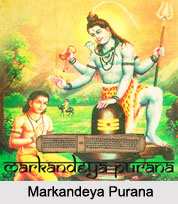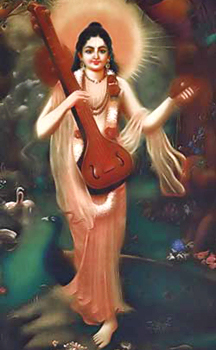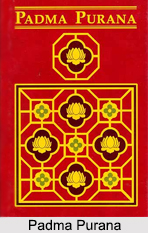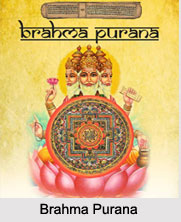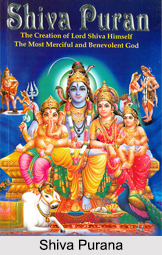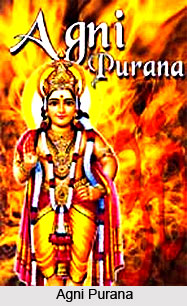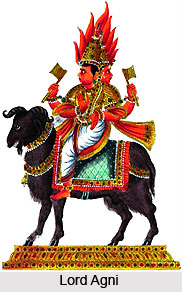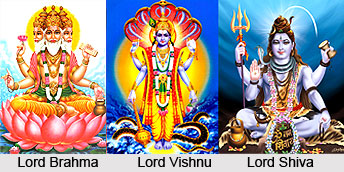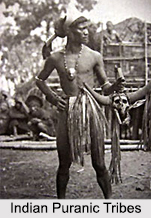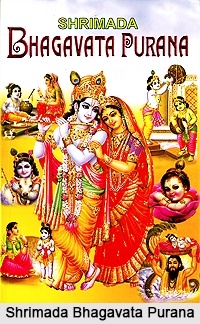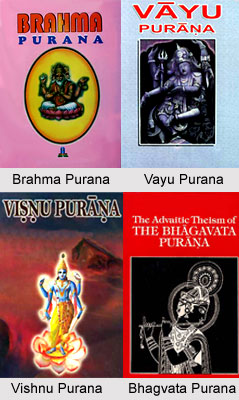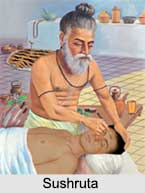 Sushruta is the son of Vishwamitra, and consequently a contemporary of Lord Rama. Sushruta is said to have studied under Dhanwantara, and his work, the "Sushruta Samhita" still exists, and is considered as a valuable treatise on Surgery. Regarded as the “Father of Surgery,†Sushruta is a well-known surgeon and teacher of Ayurveda who became popular in the Indian city of Kashi during the 6th century B.C.
Sushruta is the son of Vishwamitra, and consequently a contemporary of Lord Rama. Sushruta is said to have studied under Dhanwantara, and his work, the "Sushruta Samhita" still exists, and is considered as a valuable treatise on Surgery. Regarded as the “Father of Surgery,†Sushruta is a well-known surgeon and teacher of Ayurveda who became popular in the Indian city of Kashi during the 6th century B.C.
Legends of Sushruta
Around 2600 years ago, Maharishi Shushruta, together with his colleagues, had performed the array of complex surgeries such as "caesareans", "artificial limbs", "cataract", "urinary stones", "fractures", and most particularly the "plastic surgery". Sushruta and his fellow-students started their education under Dhanwantara. He was the first person who had classified the surgical operations and described the plastic surgery with its tools in his book of one hundred and twenty chapters in five parts.
His book "Sushruta Samhita" contains one hundred and eighty four chapters and describes 1120 types of illnesses, seven hundred medicinal plants, sixty-four preparations from mineral sources and fifty-seven preparations based on animal sources. His involvement towards the Indian traditional medicine and the ancient cultural heritage of India is valuable. After his great writing, he had become very well-known personality and his writing was first translated into the Arabic language which was also translated into the Latin and English languages.
Sushruta Samhita
The origins of surgical practice in India dates back to approximately 800 B.C., a legacy deeply entrenched in the ancient Indian system of medicine known as Ayurveda. Among the eight branches of Ayurveda, surgery, or Shastrakarma, occupies a prominent place. At the forefront of surgical knowledge in antiquity stands the venerable treatise known as the "Sushruta Samhita."
Sushruta, the esteemed author, composed the Sushruta Samhita with the primary intent of providing a comprehensive guide to physicians for the holistic treatment of their patients. Central to Sushruta`s philosophy, in alignment with the principles of Charaka, was the belief that disease emanated from imbalances within the body. Consequently, it was the solemn duty of physicians not only to aid individuals in preserving their equilibrium but also to restore it should it be disrupted. Sushruta emphasized that those engaged in the practice of medicine should exemplify balance themselves.
In delineating the qualities of an ideal medical practitioner, Sushruta extolled virtues such as equanimity, geniality, refraining from disparaging speech, physical robustness, and unwavering dedication to attending to the needs of the infirm. Such practitioners were expected to diligently adhere to the directives of the overseeing physician.
The profound influence exerted by the Sushruta Samhita is underscored by its comprehensive content. Within its pages, Sushruta not only imparts anatomical knowledge but also meticulously details surgical procedures. Remarkably, many of the innovative approaches expounded by Sushruta remain relevant in contemporary medical practice.
Of particular note is Sushruta`s expertise in two specialized fields: rhinoplasty, often regarded as an early form of plastic surgery, and ophthalmology, specifically the extraction of cataracts. Within the Shusruta Samahita, he provides an intricate account of the study of anatomy through the examination of cadavers.
Sushruta`s surgical taxonomy encompasses eight fundamental categories, each delineating distinct surgical techniques. These categories include Chedya (excision), Lekhya (scarification), Vedhya (puncturing), Esya (exploration), Ahrya (extraction), Vsraya (evacuation), and Sivya (suturing). These classifications continue to resonate as foundational principles in the domain of surgery.
Contribution of Sushruta
Sushruta is mentioned in the texts of Indian legend, Mahabharata, as the son of sage Vishwamitra, and is recognized as the earliest surgeon of the recorded history. He was the pioneer of "anaesthesia" and has promoted the proper use of wine with incense of cannabis for the "anaesthesia" idea. Sushruta had described the eight types of surgical methods such as the "excision", "incision", "scraping", "puncturing", "probing", "sravana", "apposition", "stitching". He had developed the mixture of new modules for practicing surgical procedures. He had also explained the six types of dislocation of joints and twelve varieties of fractures treatment such as "traction", "manipulation", "appositions" and "stabilization".
Sushruta"s major contribution was towards the field of Plastic and Cataract surgery. He had explained all the basic principles of plastic surgery by offering an appropriate physiotherapy before operation. He has given different other methods together with the revolving graft, sliding graft, pedicle graft, rhinoplasty and labioplasty.
Followers of Sushruta
The followers of Sushruta, known as Saushrutas, embarked on a rigorous and disciplined path to acquire proficiency in the realm of surgery and medicine. A prerequisite for commencing their practical surgical education was a comprehensive six-year period of theoretical study. This educational journey bore striking similarities to the Hippocratic Oath in its solemn commitment to the principles of healing and the imperative to abstain from causing harm to individuals.
Before delving into hands-on surgical training, these aspiring healers pledged their dedication to the art of medicine. Under the guidance of Sushruta, their esteemed mentor, they embarked on a meticulous and methodical progression towards surgical competence. This progression began with the honing of their skills on inanimate objects such as vegetables or lifeless animal specimens, with a particular emphasis on perfecting the precision of incisions in terms of length and depth.
Demonstrating adeptness in their initial practice, Saushrutas then advanced to working with soft or decomposing wood as part of their preparatory training. Moreover, they closely observed live surgical procedures conducted on patients under the watchful eye of their mentor. This immersive and comprehensive approach ensured that they gained a profound understanding of surgical techniques and the intricacies of anatomy.
Legacy of Sushruta
The enduring legacy of Sushruta, the ancient Indian physician-surgeon, is notably exemplified through his pioneering contributions to the field of surgery, particularly in the realm of rhinoplasty. His remarkable writings elucidate intricate techniques for nasal reconstructions, a procedure often necessitated for individuals who had undergone amputations as a punitive measure, including those convicted of criminal offenses.
Sushruta`s indelible impact on the practice of surgery in India is evidenced by historical accounts that attest to the perpetuation of his surgical methodologies for several centuries. These practices remained in use within the Indian medical community until the latter part of the 18th century, reflecting the enduring efficacy and relevance of his surgical innovations.
Furthermore, Sushruta`s influence extends beyond geographical boundaries. His global recognition can be found in the presence of a statue commemorating his contributions at the Royal Australian College of Surgeons in Melbourne, Australia. This statue serves as a symbol of reverence for his pioneering work and enduring legacy, underscoring the profound and lasting imprint he has left on the field of surgery and the broader medical community.

